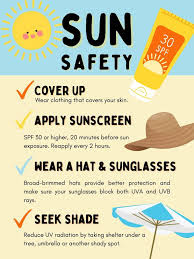
The sun, while a source of warmth and light, also emits harmful ultraviolet (UV) radiation that can wreak havoc on our skin. Prolonged exposure to the sun's UV rays can lead to a myriad of skin issues, including sunburn, premature aging, and an increased risk of skin cancer. Fortunately, with the right sun protection and sunscreen recommendations, you can shield your skin from the sun's harmful effects and enjoy outdoor activities safely. In this comprehensive guide, we'll explore the importance of sun protection, discuss the different types of UV radiation, and provide recommendations for choosing and using sunscreen effectively.
Understanding Sun Exposure and UV Radiation:
The sun emits three types of UV radiation: UVA, UVB, and UVC. UVA rays penetrate deep into the skin, causing premature aging, wrinkles, and skin cancer. UVB rays primarily affect the outer layer of the skin, leading to sunburn, tanning, and an increased risk of skin cancer. UVC rays are absorbed by the Earth's atmosphere and do not reach the Earth's surface.
Prolonged or excessive exposure to UV radiation can damage the skin's DNA, suppress the immune system, and increase the risk of skin cancer, including melanoma, the deadliest form of skin cancer. Additionally, UV exposure is a major contributor to premature aging, causing wrinkles, fine lines, age spots, and sagging skin.
Importance of Sun Protection:
Given the harmful effects of UV radiation on the skin, sun protection is essential year-round, not just during the summer months or on sunny days. Incorporating sun protection into your daily routine can help prevent sunburn, premature aging, and skin cancer, while also maintaining the health and appearance of your skin.
Sunscreen Recommendations:
Broad-Spectrum Protection:
Choose a broad-spectrum sunscreen that offers protection against both UVA and UVB rays. Look for labels indicating "broad-spectrum" or "UVA/UVB protection" to ensure comprehensive coverage.
SPF (Sun Protection Factor):
Select a sunscreen with a Sun Protection Factor (SPF) of 30 or higher. SPF measures the level of protection against UVB rays, with higher numbers indicating greater protection. While SPF 30 blocks approximately 97% of UVB rays, SPF 50 blocks about 98%, providing slightly better protection.
Water Resistance:
Opt for a water-resistant sunscreen if you'll be swimming or engaging in water-related activities. Water-resistant sunscreens provide protection for up to 40 or 80 minutes of water exposure, depending on the label.
Formulation:
Choose a sunscreen formulation that suits your skin type and preferences. Options include lotions, creams, gels, sprays, sticks, and mineral powders. Consider factors such as skin sensitivity, skin type (dry, oily, combination), and ease of application when selecting a sunscreen.
Active Ingredients:
Look for sunscreen formulas containing active ingredients like avobenzone, octocrylene, octinoxate, zinc oxide, and titanium dioxide. Chemical sunscreens work by absorbing UV rays, while physical (mineral) sunscreens create a physical barrier that reflects and scatters UV rays away from the skin.
Application:
Apply sunscreen generously and evenly to all exposed areas of skin, including the face, neck, ears, hands, and any other areas not covered by clothing. Use approximately one ounce (about a shot glass full) to cover the entire body.
Reapply sunscreen every two hours, or immediately after swimming, sweating, or towel drying, to maintain optimal protection. Even water-resistant sunscreens can wear off over time, so regular reapplication is essential for prolonged sun exposure.
Additional Sun Protection Tips:
Seek Shade: Whenever possible, seek shade during peak sun hours (10 am to 4 pm) to minimize UV exposure and reduce the risk of sunburn and heat-related illnesses.
Wear Protective Clothing: Wear lightweight, protective clothing, such as long-sleeved shirts, wide-brimmed hats, sunglasses, and UV-blocking sunglasses, to shield your skin and eyes from UV radiation.
Avoid Tanning Beds: Avoid indoor tanning beds and booths, as they emit harmful UV radiation that can damage the skin and increase the risk of skin cancer.
Check UV Index: Check the UV index regularly to gauge the intensity of UV radiation in your area and take appropriate precautions to protect your skin accordingly.
Perform Regular Skin Checks: Perform regular self-examinations of your skin to monitor for any changes, such as new moles, growths, or unusual spots, that may indicate skin cancer. If you notice any concerning changes, consult a dermatologist promptly for evaluation and treatment.
Conclusion:
Sun protection is a crucial aspect of maintaining healthy, radiant skin and reducing the risk of sunburn, premature aging, and skin cancer. By following the recommended sunscreen guidelines, seeking shade, wearing protective clothing, and avoiding indoor tanning, you can enjoy outdoor activities safely and protect your skin from the sun's harmful UV radiation. Remember that sun protection should be incorporated into your daily routine year-round, not just during the summer months, to ensure optimal skin health and longevity. With the right sun protection measures in place, you can defend your skin against the sun's damaging rays and maintain a youthful, luminous complexion for years to come.
Comments
Post a Comment